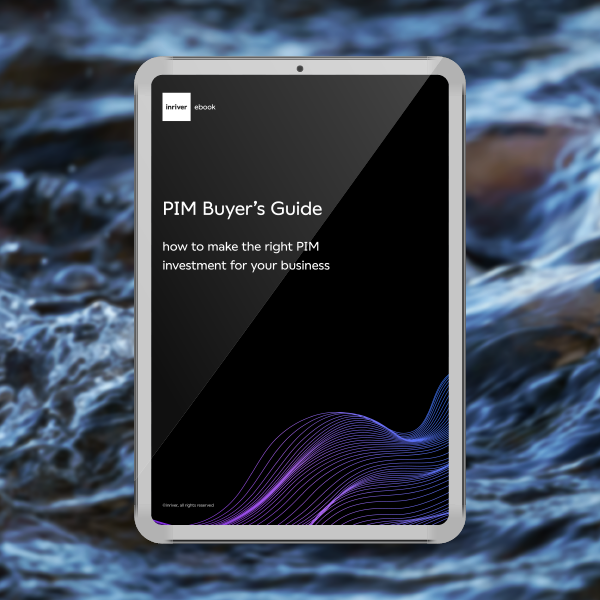PIM best practices to win in 2025
make your PIM journey a walk in the park
Understand the best PIM practices your business should be implementing to take your product information management to the next level and beyond.
As we round the midpoint of 2025, more businesses are shifting toward digital-first strategies. Amidst the evolution, one thing is certain: the ability to manage and leverage product information remains critical to success.
Enter Product Information Management (PIM), an indispensable solution that serves as the cornerstone for businesses aiming to streamline their operations and deliver exceptional customer experiences.
The importance of PIM will only continue to grow. For brands, manufacturers, and retailers, embracing PIM best practices in implementation and execution will be essential to thrive in this age of digital transformation. Read on for the top 10 PIM best practices for 2025 and beyond:
- 1. Establish data governance frameworks
- 2. Ensure integration flexibility
- 3. Implement automated data enrichment
- 4. Adopt scalable architecture
- 5. Foster collaborative workflows
- 6. Enhance personalization capabilities
- 7. Prioritize real-time data synchronization
- 8. Enable multichannel publishing
- 9. Gather analytics-driven insights
- 10. Improve continuously
1. Establish data governance frameworks
Data governance is the strategic backbone of a PIM platform, enhancing data quality and security. By putting flexible yet firm access control and data policies in place, organizations can better monitor for risks, highlight opportunities for improvement, and assign accountability. This is especially crucial in modern business where automation plays a central role and can blur the lines of responsibility.
2. Ensure integration flexibility
The effectiveness of a PIM system in boosting marketing productivity is multiplied when it seamlessly integrates with existing software solutions. Key PIM integrations include:
- Enterprise Resource Planning (ERP)
- Content Management Systems (CMS)
- Customer Relationship Management (CRM)
- E-commerce platforms
As new tech emerges, a PIM solution that seamlessly connects with your tech stack is crucial for staying competitive.

3. Implement automated data enrichment
Speaking of emerging technologies, automation—especially artificial intelligence (AI) and machine learning (ML)—is revolutionizing the PIM landscape. Many such innovations are already seeing use, with leading PIM systems utilizing tools such as:
- ML algorithms that refine and consolidate scattered data onboarding processes to improve validation efficiency
- AI-powered automation for faster, higher-quality content enrichment to ensure relevant and optimized product attributes/information
Brands, manufacturers, and retailers embracing these advancements reduce manual efforts and errors, maximizing efficiency without sacrificing quality.
4. Adopt scalable architecture
As your organization grows, so does the amount of product data you must manage. Incorporating the right PIM strategy and architecture empowers you to meet this growth effortlessly, even as you scale to new channels and markets.
In practice, this requires leveraging a cloud-based PIM solution with adaptable data models, capable of scaling resources to meet demand.
5. Foster collaborative workflows
A PIM solution should serve as your single source of truth accessible to all teams and partners involved in the product lifecycle. This centralized access promotes effective collaboration, removes silos, and accelerates the time-to-market by ensuring everyone works from the latest, most accurate data.

6. Enhance personalization capabilities
Personalization is a key driver of customer satisfaction—and sales. The best PIM systems on the market today will equip you to meet the unique preferences of key market segments. This paves the way for strategies such as:
- Tailoring shopping experiences: Suggest personalized product bundles or “frequently bought with” items based on individual shopping habits.
- Guiding customer journeys: Meet your customers where they are, making it as easy as possible for them to find the products they want.
- Deepening buyer loyalty: Implement a personalized approach that makes customers feel valued and understood, creating a positive feedback loop that keeps them coming back.
Focusing on personalization is a crucial strategy for customer retention in 2024, which in turn amplifies the returns on your PIM system investment.
7. Prioritize real-time data synchronization
If changes in your ERP or current PIM software don’t roll out to your sales channels until the next day, inefficiencies can stack up. In contrast, PIM tools with real-time data synchronization give you the flexibility to adapt to competitor movements, update product stock information, and prevent outdated data from snowballing into fragmented silos. This is essential for maintaining data accuracy across all your platforms.
8. Enable multichannel publishing
In addition to syncing internal platforms, external omnichannel publishing is an absolute must in 2024 and beyond. Advanced PIM software employs syndication to distribute product information across all digital platforms. This serves a dual purpose: ensuring omnichannel consistency and eliminating the redundancy of updating each channel manually. By managing product descriptions and information effectively, you enhance the customer experience across various touchpoints.

9. Gather analytics-driven insights
Modern businesses are built on data—so why not transform that data into a competitive advantage? Today’s top PIM systems do more than provide data. They turn that data into actionable insights that help your business run better. This is crucial for managing product information and tailoring your strategies to your specific use case.
Advanced PIM system analytics can provide insight into your key customer segments, top-performing products, market opportunities, and much more.
10. Improve continuously
Of course, simply collecting insights is not enough. Data gleaned from advanced PIM systems can then be leveraged to inform a culture of continuous improvement, resulting in:
- Optimized product listings
- Data-driven marketing strategies
- Streamlined inventory management
These practices better meet the needs of the digital shelf and rising customer expectations. A successful PIM implementation includes a commitment to ongoing enhancement, ensuring data consistency in your evolving business.

Start your PIM journey in 2025 with inriver
With strategic planning as your North Star, implementing a PIM system is a powerful way to unlock new avenues of revenue growth. For brands, manufacturers, and retailers seeking PIM best practices in 2025, the very best practice is to dive in and get started. But you don’t have to start your journey alone. At inriver, our experts provide the guidance and partnership needed to jumpstart your PIM implementation.
As an industry-leading PIM solution developed with key PIM features and ease of implementation in mind, the inriver PIM is an ideal launchpad for improved data management. Backed by our resources and best practices, you’ll have everything you need to win out over the competition in 2025—and for years to come.
want to see the inriver PIM in action?
Schedule a personalized, guided demo with an inriver expert today to see how the inriver PIM can get more value from your product information.
